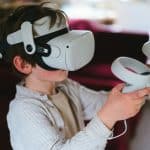Advancements in technology have revolutionized many areas of our lives, from how we learn, work, and communicate, to how we play games and experience entertainment. One of the most exciting developments in recent years has been the rise of Augmented Reality (AR). Eclipsing the realms of science fiction and video gaming, AR has transformed the way we interact with the world around us. Crucially, it has also rewritten the rules of storytelling, opening up a world of immersive, interactive experiences that captivate audiences in entirely new ways.
The Magic of Augmented Reality Storytelling
Before diving into how AR technology can be used to create interactive storytelling experiences, it’s important to understand what AR storytelling means. AR storytelling is a type of digital narrative that blends the physical and digital worlds, allowing the user to interact with the storyline in real time and in a tangible, immersive way. These interactive experiences bring stories to life, engaging users on a far more personal level.
A découvrir également : What are the ethical considerations of using AI to monitor player behaviors?
Unlike traditional storytelling mediums, AR storytelling allows the user to play an active role in the narrative. They’re not just passive observers; they’re participants, able to influence the direction and outcome of the story. This creates a deeper emotional connection and a more engaging, memorable experience.
The Mechanics of AR Storytelling
Augmented reality storytelling is powered by a range of technologies. Central to this is the use of an AR app, which requires a digital device, such as a smartphone, tablet, or specially designed AR glasses. These devices feature cameras and sensors that can recognize and track physical objects and spaces. They then overlay digital content, such as images, animations, or sound onto the physical world, creating an augmented reality.
Cela peut vous intéresser : What are the methods for ensuring smooth frame rates in VR games?
The development of these AR apps is a complex process. It involves the creation of 3D models and animations, the use of tracking technologies to accurately position this digital content within the physical world, and the development of interactivity, allowing users to engage with the digital content and influence the story.
Creating an engaging AR storytelling experience also requires clever content creation. The story must be captivating, but it must also be designed in a way that takes full advantage of the interactive and immersive nature of AR. This often involves creating multiple narrative paths that the user can steer through their interactions.
Enhancing Learning Experiences with AR Storytelling
One area where AR storytelling is proving particularly effective is in the realm of learning. Augmented reality can make complex subjects come alive, helping students to grasp concepts more easily and engage more fully in the learning process.
For example, a history lesson could be transformed into a dynamic, interactive experience where students can explore historical events, characters, and locations in a far more immersive way. Similarly, a science lesson could leverage AR technologies to create interactive models of atoms or biological systems, allowing students to explore and interact with these in a tangible, intuitive way.
The interactive nature of augmented reality also promotes active learning. Instead of passive absorption of information, learners are encouraged to engage, explore, and experiment, which can lead to a deeper understanding and better retention of the subject matter.
The Power of AR Storytelling in Marketing
Augmented reality storytelling isn’t just revolutionizing entertainment and education, it’s also making waves in the world of marketing. Brands are increasingly leveraging AR technologies to create engaging, interactive experiences that captivate their audiences and create a memorable impact.
This could involve creating an AR app that allows users to explore a product in a virtual environment, offering a far more immersive and interactive experience than traditional advertising methods. Alternatively, brands could create interactive, AR-powered stories that create emotional connections with their audiences, helping to build brand loyalty and engagement.
Crucially, AR storytelling allows marketers to break away from traditional, linear narratives, and instead, create multi-strand stories that users can explore and interact with at their own pace. This gives users more control over their experience, making it more personalized and engaging.
AR Storytelling: The Future of User Experiences
Augmented reality storytelling is still in its infancy, but its potential is enormous. As the technology continues to evolve and become more accessible, we can expect to see AR storytelling become a common feature in many different areas of our lives, from entertainment and education to marketing and beyond.
As users, we can look forward to increasingly immersive, interactive experiences that offer a whole new level of engagement and emotional connection. For creators, the challenge will be to harness the potential of this powerful technology to create compelling stories that resonate with their audiences, offering experiences that are not just interactive, but truly unforgettable.
The future of AR storytelling is an exciting realm, filled with endless possibilities. So, as we journey forward into this brave new world of interactive, immersive experiences, we can expect to see our stories, and the ways we experience them, transformed in ways we can only begin to imagine.
AR Storytelling: A Game Changer for Social Media
Social media is all about engagement and sharing experiences, and augmented reality storytelling is set to take this to another level. Instead of simply viewing content, users can interact with it, shaping their own experiences and narratives. This exciting development can take user engagement on social media platforms to unprecedented heights.
AR technology is already being used on social media platforms like Instagram, Snapchat and Facebook, with filters and interactive games. However, the next phase of AR integration will go beyond playful filters and one-off games. AR storytelling will transform social media into a platform for sharing immersive, interactive experiences.
Consider a travel blogger using AR technology to share their adventures. Rather than just posting photos and videos, they could use AR to create an interactive experience, allowing followers to virtually join the journey, explore new places, and even interact with the environment in real time. Not just a visual spectacle, this would provide a deeper, more personal connection to the narrative.
An immersive technology like AR can also play a significant role in software development for social media. Developing captivating AR stories for social media involves a blend of technology and creativity. From 3D models and animations to positioning digital content within the physical world, app development for AR storytelling presents a new frontier of possibilities for social media platforms.
Shaping the Future of Entertainment with AR Storytelling
From Hollywood to game development, the entertainment industry has always been quick to embrace new technology, and AR is no different. Augmented reality storytelling is opening up a new chapter in the entertainment world, offering audiences immersive storytelling experiences that are unparalleled.
In the film industry, filmmakers can use AR to create immersive experiences that plunge audiences directly into the narrative. Imagine watching a horror movie not from the safety of your living room but within the eerie setting of the movie itself, with the ability to explore and interact with the environment in real time.
In the gaming world, AR can transform gameplay from a passive experience to an active adventure. Players can interact with the game environment, influencing the storyline through their actions. The line between player and character blurs, creating a deeply engaging gaming experience.
Moreover, live events and concerts could also utilize AR to create immersive experiences. Instead of just watching a concert, fans could interact with the show, influencing the lighting, effects, and even the performance in real time.
As we forge ahead into the future, it’s clear that augmented reality storytelling is not just a passing fad but a revolutionary force that’s here to stay. As the technology becomes more sophisticated and accessible, we can expect to see an explosion of AR storytelling experiences across a range of sectors, from education and marketing to social media and entertainment.
Whether we’re exploring complex scientific concepts in a virtual lab, connecting with a brand through an interactive marketing campaign, sharing an adventure on social media, or immersing ourselves in a virtual reality game or movie, AR storytelling offers us a way to experience narratives like never before.
For creators, the challenge lies in mastering this burgeoning technology to craft engaging, emotionally resonant stories. For users, the thrill is in the unprecedented level of control and interaction that AR storytelling offers. As we enter this exciting new era of interactive, immersive experiences, we can expect our stories and the ways we experience them to be transformed in ways we can only begin to imagine.
In conclusion, AR storytelling is more than just a technological advancement; it’s a paradigm shift in the way we share and experience stories. Joining the revolution means embracing a future that’s immersive, interactive, and incredibly engaging.











